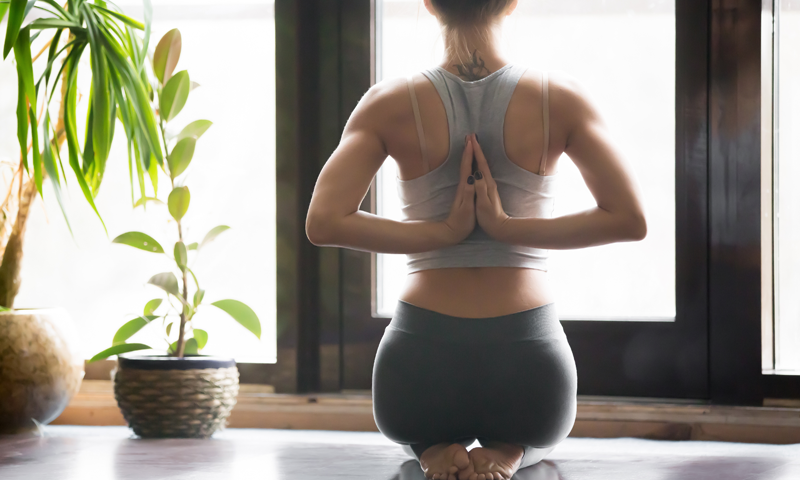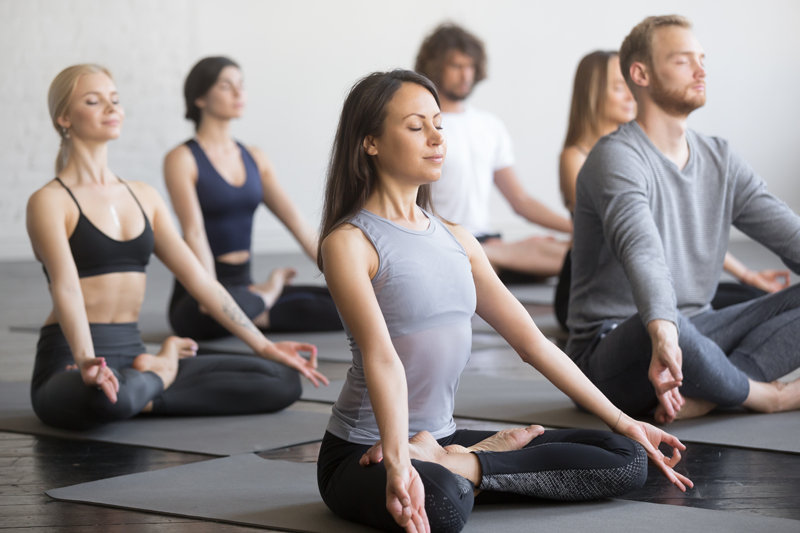
Yoga for High Blood Pressure
27th September 2019
The Essence of Yoga as Therapy
4th October 2019The Powerful Ways Yoga Can Help with Posture

Poor posture is one of the leading causes of back pain, headaches and overall aches and pains. With many of us spending our life slumped over a laptop, it’s no surprise that poor posture is a global issue. Thankfully, yoga can be used to correct it.
Studies have shown that yoga can improve poor posture and reverse posture-related health issues such as hyperkyphosis. Better still, it provides several other health benefits too, allowing you to not only improve your posture but also increase your overall wellbeing. Through a series of simple poses, yoga strengthens the muscles to improve your posture and alignment. In this article, we explore the powerful ways yoga can help with posture. If you want to follow along with the asanas, make sure you’re using a mat and wearing a comfortable yoga top.
Powerful Benefits of Correct Posture
Improved Alignment
Good posture improves bodily alignment. When you sit or stand with your body properly aligned, your organs can function optimally without unnecessary strain. One organ this affects is the stomach, meaning that good posture can improve digestion.
Pain Elimination
Good posture eliminates neck and back pain. When you’re sitting correctly, your spine and bones can easily balance your body weight and minimise the risk of back or neck injuries later down the line.
Improved Breathing
To work optimally, the lungs need space to expand in the chest. When you’re slouching, your rib cage collapses slightly, leaving less space for the lungs to open. This can lead to inefficient breathing and cause fatigue, headaches and breathlessness.
Improved Memory
As correct posture enhances your breathing, it allows you to take in more oxygen. In turn, this improves your cognitive function and improves the memory. It can also prevent the dreaded ‘brain fog’ and keep you feeling sharp and alert throughout the day.
Arthritis Prevention
Good posture keeps the bones and joints correctly aligned. Not only does this allow the muscles to be used correctly, but it also decreases unnecessary wear and tear on the joints that can lead to degenerative arthritis.

Yoga Poses to Help with Posture
Mountain Pose
To practice Mountain Pose, stand tall with your feet in line with your hips. Distribute your weight evenly through each foot, making sure that you’re not shifting your centre of gravity forward or back. Next, engage your thighs and draw your tailbone forward. Remember to keep your legs straight but your knees unlocked. Take a deep breath in and lengthen your spine as much as possible. As you exhale, draw your shoulders down and back and reach your fingertips toward the floor. On your next inhale, bring your arms up and reach your fingers toward the ceiling. Finally, bring the palms of your hands together whilst reaching your arms upward. You are in Mountain Pose. Hold the asana for around 30 seconds whilst breathing deeply.
Tree Pose
To practice Tree Pose, stand tall with your feet together. Touch your big toes together, leaving half an inch of space between your heels. Next, bring your palms together in front of your chest and engage your abdominal muscles. Slowly shift your weight onto your right foot, rooting it down by pressing firmly through the ball of your heel and big toe. Gently lift your left foot off the ground, bending the knee as you do so. When you’ve established a sense of balance, place your left foot on the inside of your right thigh. You are in Tree Pose. Hold the posture for 30 seconds before switching sides.
Cat-Cow Pose
To practice the Cat-Cow Pose, begin on all fours with your shoulders directly above your wrists and your hips above your knees. Take a deep breath in and arch your back toward the ceiling. You are in Cat Pose. As you exhale, lift your chin and arch your back toward the mat. You are in Cow Pose. Hold the position for a few seconds before alternating back to Cat Pose. Repeat the sequence for a few minutes whilst breathing deeply. In addition to promoting good posture, Cat to Cow Pose stretches the neck, chest, shoulders, and lower back. With this in mind, it can benefit those suffering from back pain and headaches.
Downward Facing Dog
To practice Downward Facing Dog, stand tall on your mat with your feet shoulder-width apart. Hinge at the waist and lower your upper body toward the ground until your hands are securely on the mat. Your body should now form a triangle. Tight hamstrings may prevent beginners from touching the ground; to make the pose a little easier, try bending your knees slightly throughout the asana. Next, move your head between your upper arms and spread your fingers for additional balance. You are in Downward Dog. For best results, breathe deeply whilst practising the pose and hang your head gently between your shoulders.
Cobra Pose
To practice Cobra Pose, lie down on your stomach. Extend your legs, keeping the tops of your feet on the floor. Next, place your hands flat on the ground, letting them lie directly under your shoulders. Gently draw your elbows back into your body whilst pressing your thighs and the tops of your feet into the ground. Stay in this position for a couple of seconds, remembering to breathe deeply. When you are ready, lift your chest off the ground by straightening both arms. Finally, press your tailbone firmly into the floor and engage your buttocks. You are in Cobra Pose. For best results, draw your shoulder blades towards your back and distribute the stretch evenly throughout the spine. Hold the posture for around 30 seconds before releasing the backbend and lowering yourself back down to the mat.
In Summary
So, there you have it – the powerful ways yoga can help with posture. If you’re hoping to improve your posture and alignment, practice the asanas above regularly. To soak up the last of the sun, consider practising yoga outside in your garden or local park. Before heading off, remember to pack a yoga cap and some suncream to protect your skin from the UV rays.

